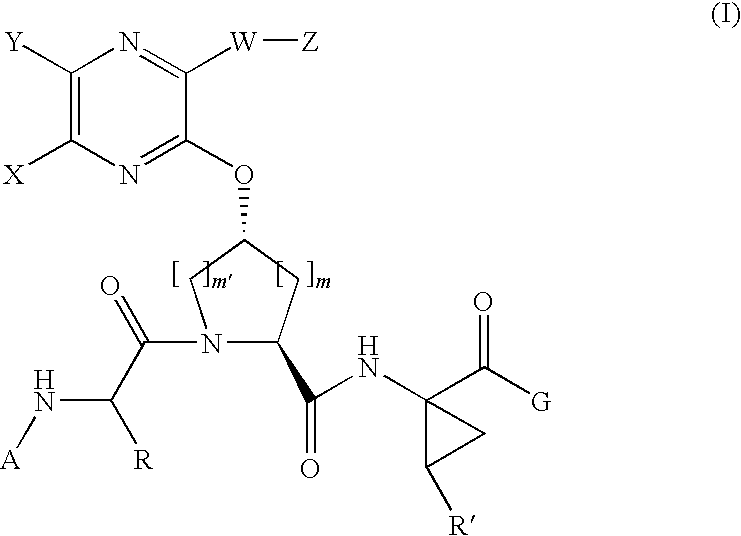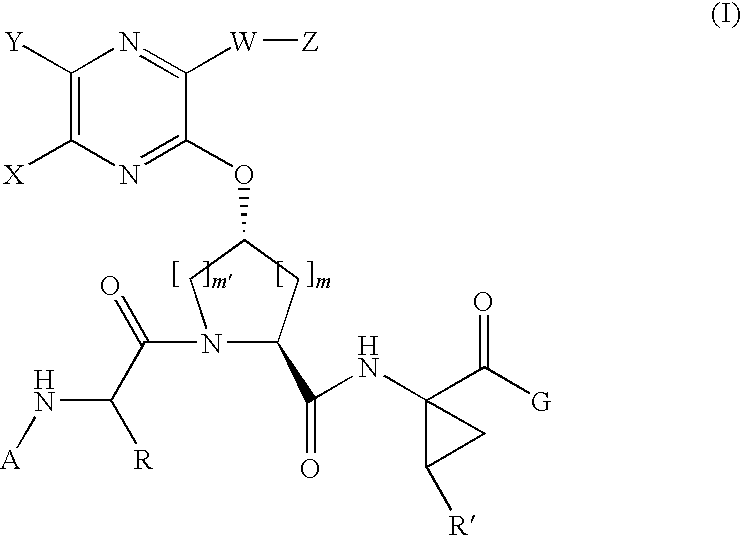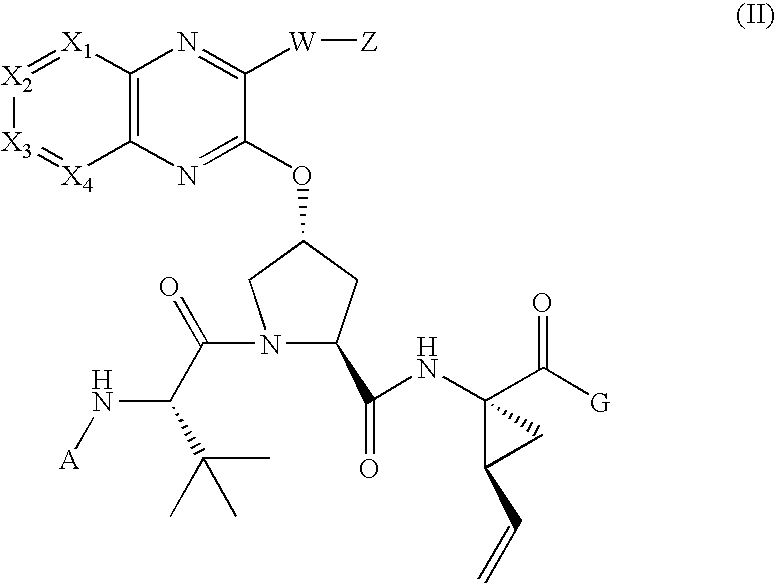Quinoxalinyl tripeptide hepatitis C virus inhibitors
a technology of hepatitis c virus and tripeptide, which is applied in the field of tripeptides, can solve the problems of interferon related side effects, inability to reproduce infectious culture systems and small-animal models for hcv, and increasing public health problems
- Summary
- Abstract
- Description
- Claims
- Application Information
AI Technical Summary
Benefits of technology
Problems solved by technology
Method used
Image
Examples
example 1
[0204]Compound of Formula IV, wherein
[0205]
Step 1A
[0206]
[0207]To a solution of Boc-L-tert-leucine (4.544 g, 19.65 mmol), cis-L-hydroxyproline methyl ester (19.65 mmol) and DIPEA (10.3 ml, 59.1 mmol) in DMF (80 ml) at 0° C. was added in portions HATU (7.84 g, 20.6 mmol). The mixture was stirred at rt for 18 h, diluted with EtOAc and washed with half-sat.-aq. NaCl four times. The organic phase was dried over anhydrous MgSO4, filtered, and then concentrated in vacuo. The resudue was purified by silica gel chromatography (Hexane / EtOAC=1:1 to 1:2) to afford compound 1a (7.8 g). MS (ESI): m / e 359.24 (M+H).
Step 1B
[0208]
[0209]To a mixture of the above 1a (1.363 g, 3.803 mmol), 3-(thiophen-2-yl)-1H-quinoxalin-2-one (0.868 g, 3.803 mmol)) and triphenylphosphine (2.0 g, 7.6 mmol) in THF at 0° C. was added dropwise DIAD (1.5 ml, 7.6 mmol). The resulting mixture was held at 0° C. for 15 min. before being warmed to room temperature. After 18 hours, the mixture was concentrated under vacuum and th...
example 2
[0216]Compound of Formula IV, wherein
[0217]
[0218]
[0219]Step 2A: Cyclopropylsulfonyl chloride (5 g, 35.56 mmol) was dissolved in 0.5 M ammonia in dioxane (200 ml, 100 mmol) at RT. The reaction was stirred at RT for 3 days. The large amount of precipitation was filtered and discarded. The clear filtrate was evaporated in vacuo and the white residue was dried on vacuum for 24 hours to give the cyclopropylsulfonamide (>90%). 1H-NMR (500 MHz, CD3Cl): δ 4.62 (2H, s), 2.59 (1H, m), 1.20 (2H, m), 1.02 (2H, m).
[0220]Step 2B: The title compound from Example 1 (37 mg, 0.056 mmol) and carbonyldiimidazole (14 mg, 0.086 mmol) were dissolved in 1 ml of anhydrous DMF and the resulting solution was stirred at 40° C. for 1 hour. Cyclopropylsulfonamide (10 mg, 0.084 mmol) was added to the reaction followed by DBU (8 ul, 0.056 mmol). The reaction mixture was stirred at 40° C. for 20 hour. The reaction mixture was diluted with ethyl acetate and washed with half-saturated-aqueous NaCl solution three time...
example 3
[0221]Compound of Formula IV, wherein A=H,
[0222]
[0223]
[0224]The title compound of Example 2 (25 mg, 0.0362 mmoL0 was treated with 4M HCl / dioxane (1 ml, 4 mmol). The mixture was stirred at room temperature for 1 hour, and concentrated in vacuo to dryness to affor the title compound (100%). MS (ESI): m / e 667.32 (M+H)
PUM
| Property | Measurement | Unit |
|---|---|---|
| temperature | aaaaa | aaaaa |
| pH | aaaaa | aaaaa |
| non-covalent | aaaaa | aaaaa |
Abstract
Description
Claims
Application Information
 Login to View More
Login to View More - R&D
- Intellectual Property
- Life Sciences
- Materials
- Tech Scout
- Unparalleled Data Quality
- Higher Quality Content
- 60% Fewer Hallucinations
Browse by: Latest US Patents, China's latest patents, Technical Efficacy Thesaurus, Application Domain, Technology Topic, Popular Technical Reports.
© 2025 PatSnap. All rights reserved.Legal|Privacy policy|Modern Slavery Act Transparency Statement|Sitemap|About US| Contact US: help@patsnap.com



